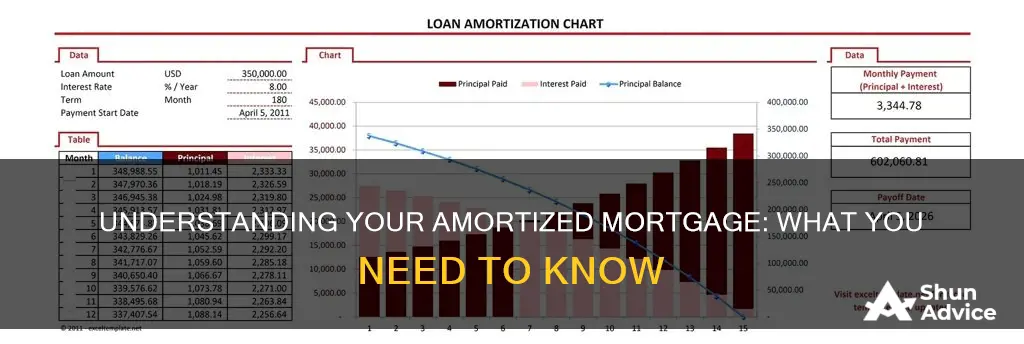
Amortization is the process of paying off a debt or loan over time in predetermined installments. An amortization schedule is a table that lists each monthly payment from the time you start repaying the loan until the loan matures or is paid off. It details how much will go toward each component of your mortgage payment — the principal or the amount you borrowed, and the interest. With mortgage amortization, a portion of your monthly payment goes toward the principal, and another portion goes to interest. The amortization schedule helps you make a plan for how extra payments can shorten the loan term and save you money.
Characteristics and Values of an amortized mortgage
| Characteristics | Values |
|---|---|
| Definition | Amortization is the process of paying off a debt or loan over time in predetermined installments. |
| Payment Schedule | A table that lists each monthly payment from the start of the loan until it matures or is paid off. |
| Payment Allocation | A portion of the monthly payment goes towards the principal (amount borrowed), and another portion goes towards interest. |
| Fixed-Rate Mortgage | Equal installments with interest making up a larger piece of the payment than the principal, initially. |
| Adjustable-Rate Mortgage | The interest rate remains fixed for a certain period, then changes periodically, causing the monthly payment to adjust. |
| Early Repayment | Making extra payments can reduce the loan balance and cut total interest costs, shortening the loan term. |
| Tax Benefits | Some types of interest, such as home mortgage interest, may be tax-deductible, allowing for deductions from taxable income. |
| Comparison | Amortization schedules help compare loan offers and make informed financial decisions. |
| Budgeting | Knowing monthly payments helps with budgeting and understanding the full cost of the loan. |
What You'll Learn
- Amortization schedules outline monthly payments and the loan term
- Amortization schedules show how extra payments reduce interest and loan terms
- Amortization schedules help calculate total interest costs
- Amortization schedules are useful for budgeting
- Amortization schedules help determine if a shorter loan term makes sense

Amortization schedules outline monthly payments and the loan term
An amortization schedule is a table that outlines the monthly payments on a loan from the time the borrower starts repaying it until it is paid off. It also shows the term of the loan. The schedule details how much will be paid towards the principal (the amount borrowed) and how much towards interest at different times over the loan's lifespan.
For example, let's say you take out a $300,000 30-year mortgage with a 6% interest rate. Excluding any additional fees and costs, your monthly payment would be $1,799 for the duration of the loan. However, your first payment would consist of $1,500 going towards interest and the remaining $299 paid towards the principal. Your second payment would consist of $1,498.51 paid towards interest—a slight reduction from the first payment. Over time, you'll pay less towards interest and more towards the principal with each payment until the loan is paid off.
The amortization schedule is useful for budgeting as it shows exactly how much you will owe each month. It also helps you understand how making extra payments can save you a significant amount of money. For instance, if you take out a 30-year, fixed-rate loan of $200,000 with a 5% interest rate, putting an extra $100 towards your principal balance with each monthly mortgage payment will save you $37,069 in interest payments over the life of the loan.
It's important to note that amortization schedules generally only work for fixed-rate loans and not adjustable-rate mortgages, variable-rate loans, or lines of credit. This is because, with an adjustable-rate mortgage, each time the interest rate changes, the loan is re-amortized over the remainder of the term to reflect the new interest rate.
Mortgage Assumption: Family Matters and Money
You may want to see also

Amortization schedules show how extra payments reduce interest and loan terms
An amortization schedule is a table that outlines the payments needed to pay off a loan. It shows how much of each payment goes towards the loan principal and how much goes towards interest. The schedule also indicates the interest and principal paid to date, and the remaining principal balance after each pay period.
Amortization schedules are particularly useful for understanding how extra payments can reduce interest and loan terms. When you take out a mortgage, you can use an amortization schedule to see how much of your monthly payments go towards the principal and how much goes towards interest. By making extra payments towards the principal, you can reduce the total amount of interest you pay over the life of the loan. This is because the interest is calculated on the current amount owed, so as the principal decreases, the interest becomes progressively smaller.
For example, let's say you take out a 30-year, fixed-rate loan of $200,000 with an interest rate of 5%. If you pay an extra $100 towards the principal with each monthly mortgage payment, you'll save $37,069 in interest payments over the life of the loan. This is a significant saving, and it shows how extra payments can reduce the overall cost of the loan.
It's important to note that amortization schedules generally only work for fixed-rate loans and not adjustable-rate mortgages, variable-rate loans, or lines of credit. Additionally, basic amortization schedules do not account for extra payments, but borrowers can still choose to pay extra towards their loans if they wish.
Hawaii's Mortgage Mystery: How Do Locals Afford It?
You may want to see also

Amortization schedules help calculate total interest costs
Amortization is an accounting technique used to periodically lower the book value of a loan or intangible asset over a set period of time. In the context of a mortgage, amortization refers to the process of paying off the loan over time in predetermined installments.
An amortization schedule is a table that lists each monthly payment from the time the borrower starts repaying the loan until the loan matures or is paid off. It details how much will go towards each component of the mortgage payment — the principal (the amount borrowed) and interest — at various times throughout the loan term. The interest is computed on the current amount owed and thus becomes progressively smaller as the principal decreases.
The amortization schedule is a powerful tool that helps borrowers understand the full cost of the loan. It shows the total interest cost, which can be useful for tax deductions, as some types of interest (such as home mortgage interest) may be tax-deductible. By studying the amortization schedule, borrowers can see how reducing the loan balance with early payments can cut their total interest costs and shorten the loan term. For example, if a borrower takes out a 30-year, fixed-rate loan of $200,000 with an interest rate of 5%$100 extra toward their principal balance with each monthly mortgage payment, they will save $37,069 in interest payments over the life of the loan.
Additionally, the amortization schedule can help borrowers budget by knowing exactly how much they will owe each month. It also provides transparency into the breakdown of monthly mortgage payments, including the principal and interest, homeowners insurance, and real estate tax costs that account for the lump sum payment.
Understanding Mortgages: Navigating the Property Buying Process
You may want to see also

Amortization schedules are useful for budgeting
Amortization is the process of paying off a loan over time through monthly payments. An amortization schedule is a table that lists each monthly payment from the time you start repaying the loan until the loan matures or is paid off. It shows how much of each payment will go towards interest and principal.
The amortization schedule also shows what portion of each payment goes towards paying down the loan balance each month and the amount that goes towards interest. This is important because, as the loan matures, the interest portion shrinks, and a larger portion of each payment goes towards reducing the principal balance.
With an amortization schedule, you can see how reducing the loan balance with early payments can cut your total interest costs and shorten the loan term. For example, if you put $100 extra towards your principal balance with each monthly mortgage payment, you could save $37,069 in interest payments over the life of the loan.
Becoming a Mortgage Field Inspector: A Step-by-Step Guide
You may want to see also

Amortization schedules help determine if a shorter loan term makes sense
Amortization is the process of paying off a debt or loan over time in predetermined installments. An amortization schedule is a table that lists each monthly payment from the time you start repaying the loan until the loan matures or is paid off. It details how much will go toward each component of your mortgage payment—principal or interest—at various times throughout the loan term.
The amortization schedule is a powerful tool that can help you determine if a shorter loan term makes sense for you. By analyzing the schedule, you can see how much of your monthly payments go toward paying down the loan balance and how much goes toward interest. This information is crucial in understanding the full cost of the loan.
For example, let's consider a 30-year, fixed-rate loan of $200,000 with an interest rate of 5%. If you refer to the amortization schedule, you will see that by putting $100 extra toward your principal balance with each monthly mortgage payment, you will save $37,069 in interest payments over the life of the loan. This demonstrates how making extra payments can significantly reduce your interest costs and shorten the loan term.
Additionally, the amortization schedule can help you budget effectively. Knowing exactly how much you owe every month can help you plan your finances accordingly. It also provides transparency into the total interest cost, allowing you to compare it against other loan offers. Furthermore, some types of interest, such as home mortgage interest, may be tax-deductible, making it important to differentiate between principal and interest contributions.
In summary, studying the amortization schedule can help you make informed decisions about your loan term. It provides valuable insights into how extra payments can reduce interest costs and shorten the loan term, assists in budgeting, and offers transparency into the total cost of the loan. By understanding the breakdown of your monthly payments, you can make better choices regarding your financial goals and work towards paying off your mortgage faster if that aligns with your priorities.
Strategies to Manage Mortgage Debt and Reduce Stress
You may want to see also
Frequently asked questions
Amortization is the process of paying off a debt or loan over time in predetermined installments.
A mortgage amortization schedule outlines each loan payment until the end of your mortgage, showing how much goes toward interest and how much reduces the principal.
To calculate amortization, multiply your principal balance by your interest rate. Next, divide that by 12 months to know your interest fee for that month. Finally, subtract that interest fee from your total monthly payment.
A mortgage amortization schedule helps you understand how much you owe every month, the total interest cost, and how reducing the loan balance with early payments can cut your total interest costs and shorten the loan term.







